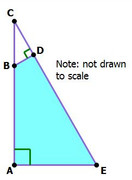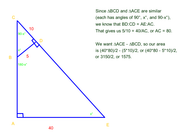Mike@Magoosh wrote: In the diagram above, BD = 5, CD = 10, and AE = 40. What is the area of the shaded region?
In the diagram above, BD = 5, CD = 10, and AE = 40. What is the area of the shaded region?
(A) 175
(B) 350
(C) 775
(D) 1150
(E) 1575
BCD and ACE both have angle C and a right angle. So the third angles of each, angle B and angle E are also the same and the two triangles are similar triangles.
From triangle BCD we see that the two non hypotenuse sides of the triangles are in the ratio 5:10 or 1:2.
The shorter side of triangle BCD, the side which is opposite angle C, corresponds to AE, which is also opposite angle C.
The longer side of triangle BCD corresponds to AC.
So the ratio of the lengths of AE and AC is 1:2.
So given that the length of side AE = 40, length of side AC of triangle ACE is 80.
Area ACE is bh/2 = (80)(40)/2 = 1600
Area BCD = (5)(10)/2 = 25
Area ACE - Area BCD = 1575.
Choose
E.
By the way Mike, I followed the link to the Magoosh site and did not see that OA and OE to this question.





















